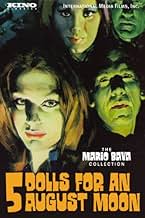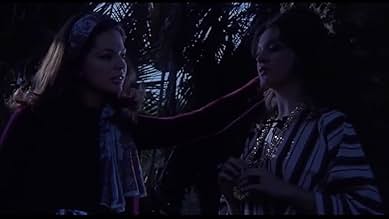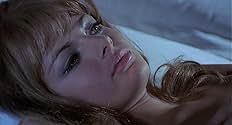AVALIAÇÃO DA IMDb
5,7/10
3,7 mil
SUA AVALIAÇÃO
Adicionar um enredo no seu idiomaAn industrialist invites his colleagues to his private island so they can exploit a resin formula invented by one of the guests, but a killer within the group disrupts the proceedings.An industrialist invites his colleagues to his private island so they can exploit a resin formula invented by one of the guests, but a killer within the group disrupts the proceedings.An industrialist invites his colleagues to his private island so they can exploit a resin formula invented by one of the guests, but a killer within the group disrupts the proceedings.
- Direção
- Roteiristas
- Artistas
- Prêmios
- 1 vitória no total
Ira von Fürstenberg
- Trudy Farrell
- (as Ira Furstenberg)
Helena Ronee
- Peggy Davidson
- (as Helena Ronée)
Teodoro Corrà
- George Stark
- (as Teodoro Corrá)
Ely Galleani
- Isabel
- (as Justine Gall)
- Direção
- Roteiristas
- Elenco e equipe completos
- Produção, bilheteria e muito mais no IMDbPro
Avaliações em destaque
One of the few films directed by Italian horror maestro Mario Bava that I hadn't seen, as well as a film starring my latest object of cinematic lust, Edwige Fenech, 1970's "Five Dolls for an August Moon" was one that I eagerly popped into my DVD player at home. And it turns out that it was well worth the wait. In this very interesting giallo, a group of businessmen convenes, with their wives, at an ultramodern beach house on what looks to be a lonely Mediterranean island, with the purpose of convincing a scientist to sell them the formula for his new industrial resin. Before long, though, "Ten Little Indians" style, the group's members start to be killed off one by one, and, in a nice, eerie touch, are kept hanging in plastic wrap in the house's meat locker. The plot here is complex enough without being ultimately impossible to understand or swallow, although one or two points do not withstand logical consideration after the movie is done. Still, Bava's direction is typically stylish, with some memorable set pieces (dig those bouncing marbles!); a chic, jazzy score by Piero Umiliani aids immeasurably in moving things along (what a terrific soundtrack CD this film could have!); and the picture, though not as graphically violent as, say, Bava's "Twitch of the Death Nerve" (1971), still provides some grisly moments. And Edwige? Well, whether doing a frenzied dance number in gold lame bell-bottoms and matching brassiere or strutting around in various states of undress, this luscious Eurobabe does not disappoint. She is easily the hottest of the "five dolls" here; whotta knockout! My thanks to Image Entertainment for this great-looking DVD of a film never released theatrically here in the U.S.
Seemingly Mario Bava was not pleased with having to direct this film. He carried out his duties as a director for hire though but despite the presence of the beautiful giallo regular Edwige Fenech, his disinterest to the project shows and the movie is wildly uneven but hugely likable. It's about an inventor who, along with a group of would-be investors, assemble on an island. The investors want a formula from the inventor and are willing to pay big for it but he does not want to sell out. Before long people start being murdered one by one. It's a variation on Agatha Christie's Ten Little Indians.
It has the breezy atmosphere that many late 60's Italian thrillers have. It wasn't until after Dario Argento's The Bird with the Crystal Plumage became an international success that the giallo genre became more direct, aggressively suspenseful and violent. Five Dolls is very much a product of the gialli that came before this. Its lounge music soundtrack and languid nature testify to this. As an actual mystery thriller it's pretty lacking it has to be said. It feels like Bava's contempt for the material is reflected in his complete indifference in creating a suspenseful or thrilling movie. While it's a whodunit with quite a number of murders, they are all committed off-screen. This is not to the film's advantage at all. Characters suddenly die from out of nowhere with no build up. Sometimes it feels like Five Dolls is a lampoon of the genre. Judging by the black humour Bava utilised in the following year's Bay of Blood it is entirely possible that he isn't taking things entirely seriously here either.
What Five Dolls does have though is a beautiful look and feel. This is hardly surprising I suppose seeing as its Bava's trademark. The cinematography is always interesting, with several well composed shots and good use of the beach-front location and villa. While the production design, fashions and cool décor are all appealing. The interest of the film, therefore, is more in watching a chic melodrama involving a group of largely unsympathetic rich people. It works better as this, than as a thriller. Still, it does have some nice macabre touches that would have graced his best films, such as the repeat scene of the murder victims hanging up in the freezer wrapped in plastic; or the shot of crystal balls rolling en mass down a set of stairs and into a bathroom leading us to yet another dead body. But perhaps best of all is the opening party scene which introduces all of the characters. It's campy to the max, with lots of slow zooms into all of the character's faces, while Fenech dances in a crazy sensual way. This sequence, like many others, benefits from the score by Piero Umiliani. It's a very eccentric soundtrack of organ-driven Italo-pop. Five Dolls is certainly a film that favours style over substance.
Five Dolls for an August Moon is not one of Mario Bava's best films but it is among his most charming. Despite the inherent weakness of its plot and mystery-thriller elements there's just something extremely likable about it. It's of its time in the best possible sense.
It has the breezy atmosphere that many late 60's Italian thrillers have. It wasn't until after Dario Argento's The Bird with the Crystal Plumage became an international success that the giallo genre became more direct, aggressively suspenseful and violent. Five Dolls is very much a product of the gialli that came before this. Its lounge music soundtrack and languid nature testify to this. As an actual mystery thriller it's pretty lacking it has to be said. It feels like Bava's contempt for the material is reflected in his complete indifference in creating a suspenseful or thrilling movie. While it's a whodunit with quite a number of murders, they are all committed off-screen. This is not to the film's advantage at all. Characters suddenly die from out of nowhere with no build up. Sometimes it feels like Five Dolls is a lampoon of the genre. Judging by the black humour Bava utilised in the following year's Bay of Blood it is entirely possible that he isn't taking things entirely seriously here either.
What Five Dolls does have though is a beautiful look and feel. This is hardly surprising I suppose seeing as its Bava's trademark. The cinematography is always interesting, with several well composed shots and good use of the beach-front location and villa. While the production design, fashions and cool décor are all appealing. The interest of the film, therefore, is more in watching a chic melodrama involving a group of largely unsympathetic rich people. It works better as this, than as a thriller. Still, it does have some nice macabre touches that would have graced his best films, such as the repeat scene of the murder victims hanging up in the freezer wrapped in plastic; or the shot of crystal balls rolling en mass down a set of stairs and into a bathroom leading us to yet another dead body. But perhaps best of all is the opening party scene which introduces all of the characters. It's campy to the max, with lots of slow zooms into all of the character's faces, while Fenech dances in a crazy sensual way. This sequence, like many others, benefits from the score by Piero Umiliani. It's a very eccentric soundtrack of organ-driven Italo-pop. Five Dolls is certainly a film that favours style over substance.
Five Dolls for an August Moon is not one of Mario Bava's best films but it is among his most charming. Despite the inherent weakness of its plot and mystery-thriller elements there's just something extremely likable about it. It's of its time in the best possible sense.
An industrialist invites some of his friends to his island retreat in order to persuade a chemist (William Berger better known as Django}to sell them his new secret formula for an industrial resin. Of course he doesn't want to sell at any price and this leads to resentment and veiled threats which leads to all on the island being killed off one by one, in this "Ten little Indians" type thriller and of course there is a storm brewing and the phones are down, I think you get the picture
.Now how do I review a Bava film without mentioning "Stylish" or "Superb use of Colour"
. I don't think I can really,but I will try
..This films theme is reminiscent of Bava's more famous work Bay of Blood, with its high body count
.it has a funky little score too, very 60's
..the film at times tends towards black comedy with the body bags swinging in the freezer, I have to say it made me laugh and as with all Bava films the women are quite nice to look at
in particular Edwige Fenech a lady I have heard a lot about and I can see why
.all in all an enjoyable little thriller, not Bava's best work but certainly worth a look
Art direction and cinematography are as distinctive as any of Bava's other giallo films of the period, but the garbled script to what is essentially little more than a standard body-count movie really lets this one down. After a plodding and talky start, the film disintegrates into a total mess. Bava pulls off the odd visual flourish, but such scenes never gel together. Still, the mesmeric use of zooms, focus pulls, and tracking shots and the stylish use of colour ensures that, from an entirely aesthetic perspective, this film never becomes boring, and as an auteur piece, is well worth a watch. Now, if only I could work out what the hell happened in it...
It has striking set pieces, sets, and color schemes. A pity the plot is not more original. But Bava's morbid sense of humor permeates the film.
Five couples come to an island for rest and relaxation. There is a maid and manservant. One of the guests tries a sacrifice--to whom, what or why isn't explained. The lights go out. The sacrifice is dead when the lights come back on--or is she? One of the guests is an inventor with an invention worth millions. After turning down three financial offers for the formula to it, people start dying. The boats that are an avenue of escape are stolen and the only telephone line is cut. The list of suspects dwindles. Will anyone survive the movie?
The cinematography was done by Antonio Rinaldi. Bava himself did the quick, jumpy editing, which contributes to the viewers' sense of unease. The dominant colors in this film are dark blue and purple, especially at night; in three scenes, the only colors used are black, white, and red. The actors are adequate.
The plot isn't exactly logical and the ending comes close to breaking the bounds of disbelief. It's like Bava gave up on everything but the visuals. So the plot may become unbelievable, but the film's a visual feast and Bava keeps things moving so I didn't have time to get bored.
Five couples come to an island for rest and relaxation. There is a maid and manservant. One of the guests tries a sacrifice--to whom, what or why isn't explained. The lights go out. The sacrifice is dead when the lights come back on--or is she? One of the guests is an inventor with an invention worth millions. After turning down three financial offers for the formula to it, people start dying. The boats that are an avenue of escape are stolen and the only telephone line is cut. The list of suspects dwindles. Will anyone survive the movie?
The cinematography was done by Antonio Rinaldi. Bava himself did the quick, jumpy editing, which contributes to the viewers' sense of unease. The dominant colors in this film are dark blue and purple, especially at night; in three scenes, the only colors used are black, white, and red. The actors are adequate.
The plot isn't exactly logical and the ending comes close to breaking the bounds of disbelief. It's like Bava gave up on everything but the visuals. So the plot may become unbelievable, but the film's a visual feast and Bava keeps things moving so I didn't have time to get bored.
Você sabia?
- CuriosidadesAgatha Christie's original story was titled "Ten Little Niggers", which had previously been filmed under such official titles as O Vingador Invisível (1945) and E Não Sobrou Nenhum (1965). The source of the story went uncredited. Mario Bava did not care for that story, but his next feature, Mansão da Morte (1971), was practically a rewrite, on which he enjoyed total control.
- Erros de gravaçãoAt 66 minutes, a crew member can be seen holding the mirror that is causing the sun's reflection.
- Citações
Nick Chaney: So what was I telling you?
Marie Chaney: That I'm a dirty whore. That's why I'm taking a shower... at least now I'll be a clean whore.
- ConexõesReferenced in O Exorcismo de Lisa (2004)
- Trilhas sonorasFive Dolls
Written by Piero Umiliani
Performed by Cantori Moderni Di Alessandroni
Courtesy of Disco Cinevox Records
Principais escolhas
Faça login para avaliar e ver a lista de recomendações personalizadas
Detalhes
- Data de lançamento
- País de origem
- Idioma
- Também conhecido como
- Five Dolls for an August Moon
- Locações de filme
- Anzio, Roma, Lazio, Itália(location)
- Empresa de produção
- Consulte mais créditos da empresa na IMDbPro
- Tempo de duração1 hora 22 minutos
- Mixagem de som
- Proporção
- 1.85 : 1
Contribua para esta página
Sugerir uma alteração ou adicionar conteúdo ausente

Principal brecha
By what name was Cinco Bonecas pela Lua de Agosto (1970) officially released in India in English?
Responda




























